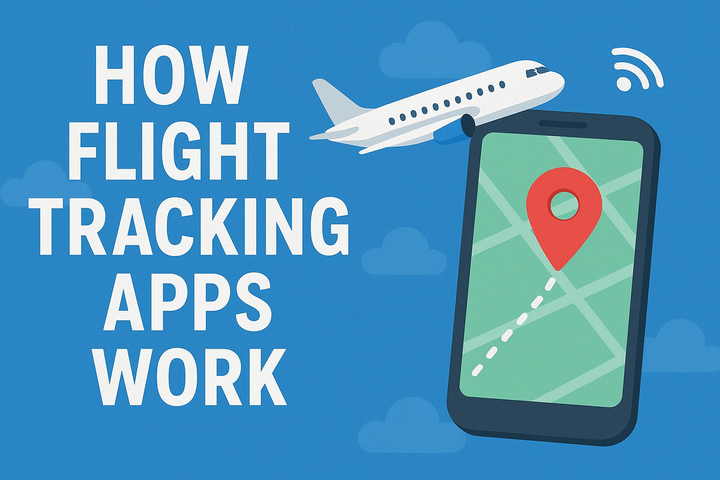Inside the Cockpit: Where the Magic (and 1,000 Buttons) Live
Ever wondered what really happens behind the cockpit door? From takeoff to landing, explore the pilots, tech, and teamwork that turn chaos into calm. Discover how this high-tech control room keeps your flight smooth and safe above the clouds.

Picture this: you’re boarding a flight, juggling a backpack, a coffee, and mild anxiety about whether 22B is next to the window or the bathroom. You glance to your left and catch a glimpse of the cockpit: a small, glowing room full of screens, buttons, and pilots who look like they’re about to launch a rocket.
Then, the door closes, the mystery deepens, and you’re left wondering: What exactly goes on in there?
Let’s find out. Buckle up, stow your tray table, and welcome aboard this behind-the-scenes tour of the cockpit: the beating heart of every flight.
Meet the Pilots: The Humans Behind the Headsets
Every cockpit is home to a two-person team (usually):
- Captain - The senior pilot, left seat, ultimate decision-maker, and the one whose calm voice reassures you mid-turbulence.
- First Officer (Co-pilot) - The equally trained right-hand flyer who shares flying duties and responsibilities.
Contrary to what many passengers assume, the first officer isn’t an “assistant.” Both pilots are certified to fly the plane; one simply has more years in the captain’s chair.
So the next time you hear, “This is your captain speaking,” remember, there’s a whole partnership behind that voice.

The Cockpit: Organized Chaos
Stepping into a cockpit for the first time can be intimidating. It looks like someone glued an entire computer store to the walls. But to pilots, it’s home: a perfectly ordered environment where every switch and screen has a purpose.
Here’s the layout:
- Front and Center: Large digital screens showing altitude, airspeed, and direction. Think of them as the plane’s dashboard, but smarter.
- Overhead Panel: The brain of the airplane. Lights, hydraulics, fuel systems, cabin pressure, it all lives here.
- Center Console: Throttle levers, communication panels, and flight management computers.
- Side Panels: Radios, circuit breakers, and sometimes a sneaky place for snacks.

Buttons, Screens, and (Controlled) Chaos
Every pilot’s office comes with its share of controls and they all serve a purpose. Let’s decode a few of the most important ones.
The Yoke or Sidestick
This is how pilots steer the aircraft. Boeing aircraft use a yoke (like a steering wheel), while Airbus opts for a sidestick (like a gaming joystick).

The Flight Displays
- Primary Flight Display (PFD): Shows attitude, airspeed, altitude, and heading. Lose this, and things get tense fast.
- Navigation Display (ND): A live map that tracks the plane’s route, weather, and nearby traffic.
The Flight Management System (FMS)
The FMS is the brain that handles navigation, fuel calculations, and performance. Pilots input waypoints, altitudes, and routes before takeoff, and the system helps manage everything from climb rates to descent speeds.

Pre-Flight: The Calm Before the Takeoff
Before you even board, the cockpit is already buzzing. Pilots arrive early to prep the flight. Here’s what happens behind that closed door:
- Flight Plan Review: The route, altitude, weather, and alternate airports are checked.
- System Checks: Lights, hydraulics, engines, everything gets tested.
- Fuel Calculation: Pilots double-check that the plane has enough fuel (plus reserves).
- Briefings: They discuss who’s flying, expected turbulence, and possible reroutes.

Takeoff: Showtime
The most thrilling part of any flight: takeoff, where teamwork truly shines.
The captain (or first officer, depending on the leg) pushes the throttles forward. Engines roar, airspeed climbs, and the other pilot calls out key speeds:
- “80 knots!” - Instruments working correctly.
- “V1!” - The point of no return.
- “Rotate!” - Time to lift off.
Once airborne, the landing gear retracts, the flaps adjust, and autopilot takes over.

Autopilot: Not Lazy, Just Efficient
Let’s clear up one of aviation’s biggest myths: autopilot does not fly the plane by itself.
Autopilot helps manage speed, altitude, and heading, but pilots remain in command the entire time. They monitor systems, communicate with air traffic control, and adjust as needed.
Example: If there’s turbulence or a reroute, pilots disconnect autopilot, take manual control, and re-engage it once conditions stabilize.

Cruise: The Quiet Complexity
At cruising altitude, it might look calm in the cabin, but the cockpit is anything but idle.
Here’s what happens mid-flight:
- Constant monitoring of fuel flow, systems, and weather.
- Updates with air traffic control about altitude or route changes.
- Cross-checking navigation and adjusting for winds.
Snack Break: Yes, this is when pilots finally get to sip that coffee. But even then, one pilot is always “flying,” while the other monitors.
The Weather Factor
Weather is a pilot’s favorite frenemy. It’s unpredictable, unavoidable, and always demands respect.
Cockpit weather radar helps pilots see storms and turbulence ahead. They can request altitude changes or slight course deviations to avoid the worst of it.
Emergencies: Calm Under Pressure
You’ve seen it in movies: alarms blaring, lights flashing, but in real life, pilots are trained to handle emergencies with calm precision.
Every pilot trains repeatedly in simulators for every imaginable situation: engine failures, hydraulic loss, electrical faults, even bird strikes.
Training Secret: Pilots spend more time practicing emergencies than normal flight operations. They train until their reactions are instinctual.
Descent and Landing: Controlled Drama
Landing is often considered the most challenging phase of flight, it’s where physics, precision, and weather all collide.
The descent begins 20-30 minutes before touchdown. Pilots manage altitude, speed, and air traffic instructions to line up perfectly with the runway.
Crosswind Landings: Pilots tilt the plane into the wind and straighten it just before touchdown. It looks dramatic from the cabin, but it’s all part of the plan.
Crosswind Landing (credit: Ynterstella)
The Cockpit at Night
If you’ve ever wondered what the cockpit looks like mid-flight in the dark, it’s stunning.
All lights are dimmed, displays glow softly, and the outside world is a blanket of stars. Pilots fly through pitch-black skies guided only by instruments and tiny navigation lights.

From Steam Gauges to Glass Screens
Cockpits have evolved dramatically. Older planes used hundreds of analog “steam gauges.” Today’s aircraft use digital “glass cockpits,” where screens replace dials and provide integrated data.
Technology has made flying safer than ever, but it still relies on human skill to interpret and act on that data.

The Sky Isn’t the Limit: It’s the Office
When you peek inside a cockpit, you’re not just looking at buttons, switches, and glowing screens, you’re looking at the nerve center of modern aviation. It’s a place where precision meets instinct, where pilots juggle weather forecasts, air traffic chatter, and computer readouts with the calm of someone making coffee on a Monday morning. Every light and lever has a story, and every decision echoes thousands of feet below.
The cockpit might seem intimidating at first glance, but it’s also a reminder of just how far technology and teamwork have brought us. Pilots today aren’t just steering a metal tube through the clouds, they’re managing a flying ecosystem of automation, navigation, and communication.
So the next time you’re buckled into your seat and the captain greets you from up front, take a second to imagine what’s happening behind that locked door. It’s not chaos: it’s choreography. A quiet, calculated dance between humans and machines, all working to make sure your journey through the sky feels effortless.
Because inside the cockpit, it’s not just about flying planes, it’s about mastering the art of staying calm, curious, and a few steps ahead of the clouds.





Comments ()